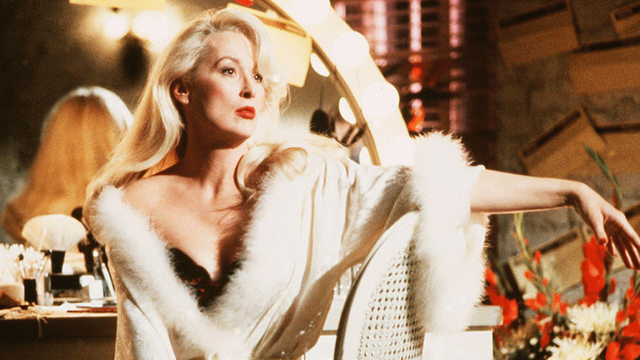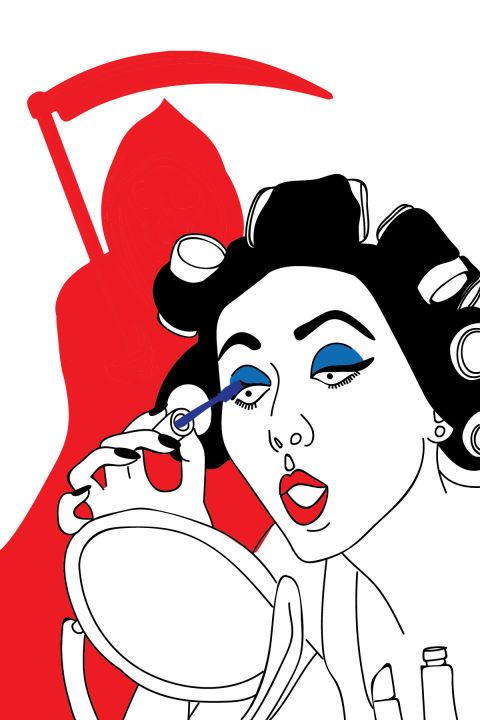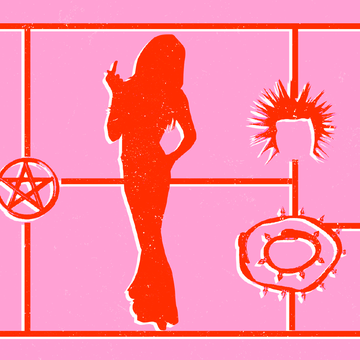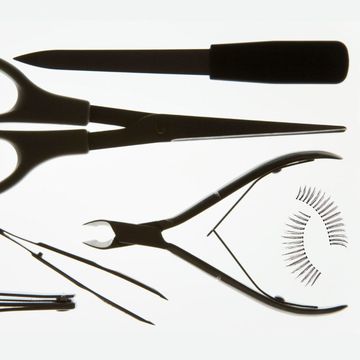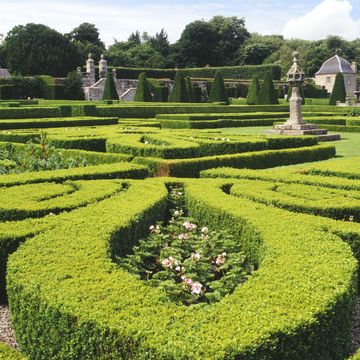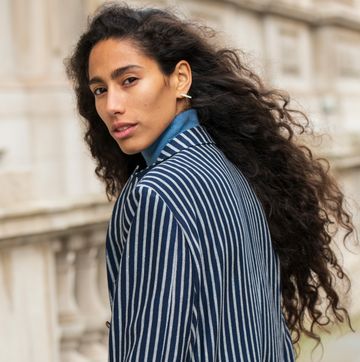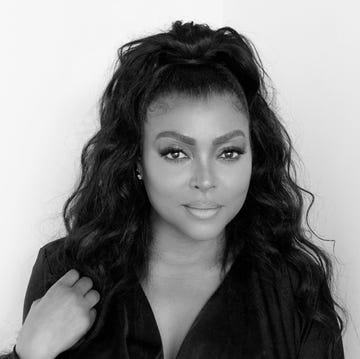Welcome to Beauty and Death, a column that examines beauty rituals. Why do we continue to invest time, money, and energy in our bodies despite the inevitability of death? Is it because these rituals stave off signs of mortality and distract us from our questions about the meaning of life? Melissa Broder—a.k.a. @sosadtoday—wants to find out.
As a person with high levels of existential terror and hypochondria, I feel like I am dying multiple times per day. With each anxious sensation—shortness of breath, rapid heartbeat, dizziness—I can't help but think that the end is near.
One of the ways I distract myself from my anxieties—general, obsessive, and even the panic attack variety—is to mimic copious YouTube makeup tutorials for looks that I will never quite master. Somehow, the obsessive quest for that perfect winged eyeliner and brushed-out brow look turns into a distraction from larger, more existential obsessions.
I also find the importance placed by beauty vloggers on achieving these looks to be soothing in the face of anxiety. We're all going to die, but it's as though the vloggers don't know this. Somehow, in spite of our mortality, it's the achievement of a perfect nighttime neutral look that remains most imperative. The grim reaper is on his way, but the vloggers are presenting Beauty Blender do's and don'ts with all the focus and gravitas of surgeons. When I elevate beauty to the highest priority and channel my free-floating anxiety there, it's the deeper stuff that begins to seem less major.
One would think, as a person who feels like she is dying multiple times a day, that I would be more prepared for my own death. Actually, the opposite is true. But recently, while calming myself with a "monochromatic shadow for aging eyes" tutorial, I thought: What if I could marry the two—the thing I am most afraid of and the makeup I use to self-soothe? If I can select my death makeup in advance, will the dying process seem less scary?
And so I set out in search of an expert who can help me choose my eternal look—someone who, perhaps, works as an embalmer, but also has a great aesthetic sense. In conducting my research, I notice that many funeral homes still use AOL and Earthlink for email. Sorry, but no. I'm not letting anyone with an Earthlink email address do my makeup.
Eventually I find Chelsea Carter, a funeral director and apprentice embalmer at Hillside Memorial Park and Mortuary in Los Angeles, who uses Gmail. Chelsea began her journey as a pre-med student, then attended makeup college and did special effects makeup for a while. It was her mother who suggested that she try juxtaposing her two passions—science and makeup—and soon she found herself in mortuary school. Her first job was to replace a missing piece in the face of a deceased person. She now handles 800 calls a year.
"I love getting requests," says Chelsea. "Sometimes I'll get pictures of a deceased person from 50 years ago and the family is like, 'We want mom to look like this,' and I'm like, 'Uh, okay. I'm going to somehow make her grow a head of hair and give her huge lips.'"
I ask her if I'm the first person to choose her own death look in advance. She says that some people do a pre-arrangement where they set out what casket they want, the clothing they'd like to wear. But most people don't think about the makeup, because they don't want to.
"I want to think about it," I tell her. "What do I need to consider?"
"Well, on a living person with eyes open and mouth moving, there are certain things that I'm going for," she says. "I want the lashes to be lifted and the eyebrows in the right spot in making expressions. I want a certain contour on the face. But when someone is laying down…people will be like, 'Oh yeah, I want blue eyeshadow on mom, because that's what she always wore,' or 'Purple cat-eye.' But it's so much different when someone's eyes are closed."
I find this inspiring, because I have hooded eyes: the kind that render eyeshadow tutorials impossible, as my lids are concealed by a layer of skin. But in death, my eyes will be closed and my whole lid will become a canvas. Will I be able to rock that dream-look I've always failed to achieve in life: the grey smoky eye?
Unfortunately, Chelsea advises against a heavy shadow. The purpose of shadow is to give the eye definition. But with the eye closed, there isn't as much of a reason to define the crease. Additionally, Chelsea hopes that I will be old when I die, and doesn't think that a smoky eye is the best look at 90. If I really want it, she says that she can do a modified version along the lashline without incorporating the whole lid. But what she would prefer for me is more of a no-makeup makeup look—something that will revive the pink tone in my skin (I won't have any circulation), a good base, a darkened lash—more of a skincare-as-makeup look.
"Can you make me look dewy and glowy?" I ask. "I'm not great at hydration."
Chelsea says this will actually be easier in death than in life, because my skin will be pliable. She can literally move my muscles into whichever shape she wants. It will be very easy to make me look peaceful, because everything will be very relaxed. Death, apparently, is nature's botox.
She also lets me know that she will be liberal in her use of fillers. When I ask her if that's going to cost more, she says it's all included. Apparently they use cheaper chemicals than those used on the living, because no one's quality of life is going to be affected.
"I sometimes joke that I'm a plastic surgeon on the low," says Chelsea. "There have been times that I've made someone look so good that people are like, 'Oh my god, I don't even know who that is. They haven't looked like that in ten years.'"
Next we move on to the lip. I know Chelsea wants no-makeup makeup for me, but I feel nervous about forgoing my favorite: a bright red gloss. She says that I'm in luck, because the viewing area at Hillside uses bulbs that are warm and soft: all pink and amber. Everything, including me, will have a warm wash. So if she uses a more muted shade of red, it will be impossible to tell the difference between that color and my traditional bright gloss.
I ask Chelsea if working with the dead has given her any peace around her own death. She says that she feels privileged, because now she knows what the process is like and will be able to speak up about what she wants for her own death look.
"I feel like my anxiety around death and dying is very much calmed by working here," she says. "Now I see that it literally happens to every single person and thing, ever."
My only remaining concern is what to do with my hair. Growing up, I had nice, soft hair until around 13, when my Jewish DNA freaked the fuck out and turned it into a giant shrub. It took me another 13 years to learn how to manage it—mostly thanks to an arsenal of chemicals that are probably already edging me closer to the funeral home. I'm nervous about how my coif will look when I'm not there to supervise.
But Chelsea seems to understand the logistics of long, coarse Jew hair. She assures me that she will definitely condition. If we go with a straight look she will use a flat-iron. If we do more of a beachy wave, as is my preference, she will still heat-style the hair and use frizz protectors.
With the words "heat style" and "frizz protectors," I finally feel confident that I'm going to look hot. Dead me is going to be me on my best day. What's nice is that I won't have to take any selfies. What's sad is that I won't be there to see it.
